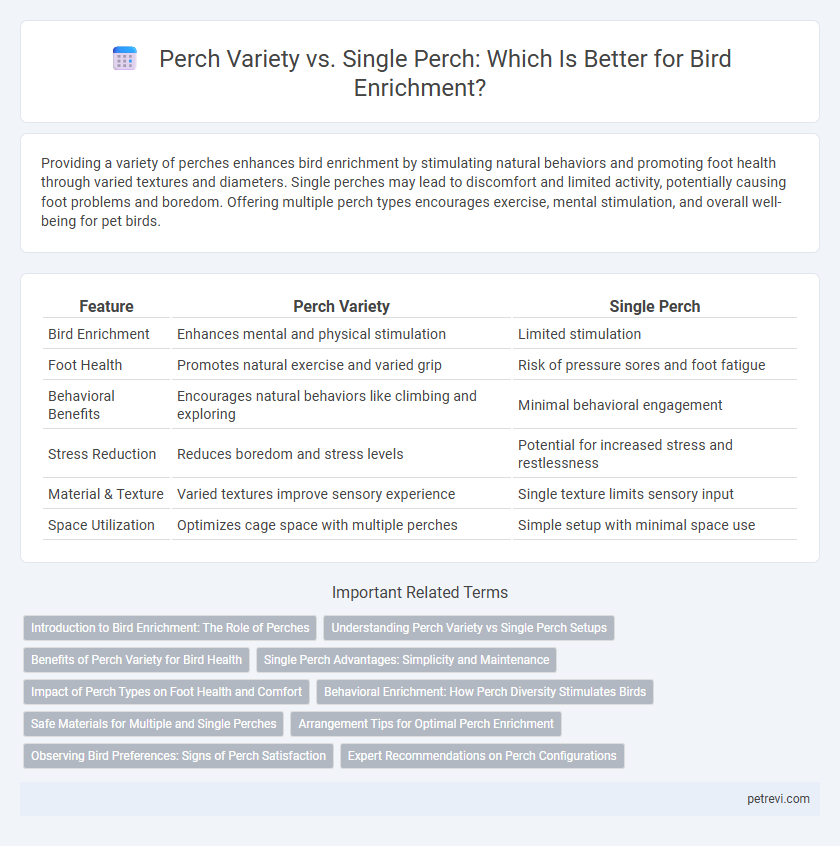Providing a variety of perches enhances bird enrichment by stimulating natural behaviors and promoting foot health through varied textures and diameters. Single perches may lead to discomfort and limited activity, potentially causing foot problems and boredom. Offering multiple perch types encourages exercise, mental stimulation, and overall well-being for pet birds.
Table of Comparison
| Feature | Perch Variety | Single Perch |
|---|---|---|
| Bird Enrichment | Enhances mental and physical stimulation | Limited stimulation |
| Foot Health | Promotes natural exercise and varied grip | Risk of pressure sores and foot fatigue |
| Behavioral Benefits | Encourages natural behaviors like climbing and exploring | Minimal behavioral engagement |
| Stress Reduction | Reduces boredom and stress levels | Potential for increased stress and restlessness |
| Material & Texture | Varied textures improve sensory experience | Single texture limits sensory input |
| Space Utilization | Optimizes cage space with multiple perches | Simple setup with minimal space use |
Introduction to Bird Enrichment: The Role of Perches
Perches play a crucial role in bird enrichment by promoting physical exercise and mental stimulation essential for avian health. A variety of perch types, including different textures and diameters, supports natural behaviors like gripping and foraging, reducing stress and preventing foot problems. Single perches limit movement and stimulation, while diverse perching options mimic wild environments, enhancing overall bird well-being.
Understanding Perch Variety vs Single Perch Setups
Providing birds with perch variety enhances foot health and mental stimulation by mimicking natural environments where different branch sizes and textures are encountered. Single perch setups may lead to discomfort and repetitive stress injuries due to uniform grip and lack of exercise diversity. Incorporating multiple perch types, such as wooden, rope, and natural branches, supports optimal avian enrichment and well-being.
Benefits of Perch Variety for Bird Health
Providing birds with a variety of perch types promotes better foot health by encouraging natural gripping and exercise, reducing the risk of pressure sores and arthritis. Different textures and diameters stimulate sensory engagement and muscle development, contributing to overall physical and mental well-being. Incorporating multiple perch options enhances bird enrichment by mimicking natural environments, supporting balanced foot morphology and preventing repetitive strain injuries.
Single Perch Advantages: Simplicity and Maintenance
Single perches offer simplicity in design, making them easy to install and clean, which reduces maintenance time significantly. Their straightforward structure minimizes the risk of bacteria buildup and allows for quick inspection of bird feet health. This simplicity supports better hygiene and less stress for both birds and caretakers compared to complex perch variations.
Impact of Perch Types on Foot Health and Comfort
Offering a variety of perches with differing textures, diameters, and materials promotes natural foot exercise, preventing pressure sores and arthritis in birds. Single perch setups often lead to repetitive strain and foot deformities due to constant pressure on the same spots. Diverse perch environments enhance circulation and comfort, directly supporting optimal foot health and bird well-being.
Behavioral Enrichment: How Perch Diversity Stimulates Birds
Offering a variety of perches with different textures, diameters, and materials enhances behavioral enrichment by encouraging natural foot movements and preventing foot fatigue in birds. Diverse perches stimulate mental engagement, promote exercise through varied gripping challenges, and reduce stress-related behaviors such as feather plucking. In contrast, single-type perches may limit these benefits, leading to decreased activity and potential health issues.
Safe Materials for Multiple and Single Perches
Choosing safe materials for bird perches is essential to prevent toxins and injuries; natural wood, untreated branches, and non-toxic plastic are ideal for both perch variety and single perch setups. Multiple perches made from varied safe materials promote foot health and mental stimulation by mimicking natural environments. Single perches must also be crafted from sturdy, bird-safe materials to support posture and avoid splinters or harmful chemicals.
Arrangement Tips for Optimal Perch Enrichment
Offering a variety of perch types such as natural wood, rope, and stone encourages foot muscle exercise and prevents joint stiffness in birds. Arranging perches at different heights and diameters promotes natural movement and reduces boredom by mimicking a bird's natural environment. Avoid placing perches directly above food or water to maintain hygiene and encourage more active engagement.
Observing Bird Preferences: Signs of Perch Satisfaction
Birds exhibit clear signs of perch satisfaction when given a variety of perches, such as increased time spent perching, relaxed posture, and frequent preening. Single perch setups often lead to signs of discomfort or boredom, including restlessness and feather plucking. Monitoring these behavioral cues helps determine optimal perch enrichment tailored to individual bird preferences.
Expert Recommendations on Perch Configurations
Experts recommend providing a variety of perch types to enhance bird enrichment by promoting natural behaviors and improving foot health. Diverse perch materials, diameters, and textures prevent foot problems like bumblefoot and encourage exercise, which single perches do not adequately stimulate. Incorporating multiple perches at different heights and positions creates a dynamic environment that supports mental stimulation and physical well-being.
Perch Variety vs Single Perch for Bird Enrichment Infographic

 petrevi.com
petrevi.com